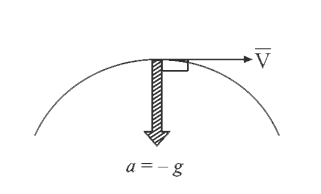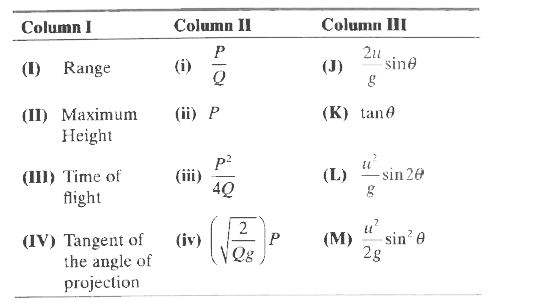In a projectile motion the velocity
is always perpendicular to the acceleration
is never perpendicular to the acceleration
is perpendicular to the acceleration for one instant only
is perpendicular to the acceleration for two instant
The correct Answer is:C
→v⊥−a at the Top. 
Similar Questions
Assertion: In projectile motion, the vertical velocity of the particle is continoulsy decreased during its ascending motion.
Reason: In projectile motion downward constant acceleration is present in vertical direction.
View SolutionAssertion In case of projectile motion, the magnitude of rate of change of velocity is variable.
Reason In projectile motion, magnitude of velocity first decreases and then increases during the motion.
View Solution
Knowledge Check
In a projectile motion, velocity at maximum height is
Aucosθ2BucosθCusinθ2DNone of theseIn ain oblique projectile motion if the velocity of projection is increased by 2%, the percentage increase in horizontal range will be
A1%B2%C3%D4%In each question, there is a table having 3 columns and 4 rows. Based on the table, there are 3 questions. Each question has 4 options (a), (b), ( c) and (d), ONLY ONE of these four options is correct.
The particle is projected in projectile motion with velocity u at an angle θ with horizontal is represented by y=Px−Qx2. Answer the questions by appropriately matching the information given in the three columns of the following table.

For which quantity of projectile motion P and Q are linearly dependent to each other and what is the relation between them?A(II) (iv) (K)B(IV) (ii) (M)C(III) (iii) (J)D(I) (i) (L)
Projectile motion is a combination of two one-dimensional motion: one in horizontal and other in vertical direction. Motion in 2D means in a plane. Necessary condition for 2D motion is that the velocity vector is coplanar to the acceleration vector. In case of projectile motion, the angle between velocity and acceleration will be 0∘<θ<180∘. During the projectile motion, the horizontal component of velocity ramains unchanged but the vertical component of velocity is time dependent. Now answer the following questions:
A particle is projected from the origin in the x-y plane. The acceleration of particle in negative y-direction is α. If equation of path of the particle is y=ax−bx2, then initial velocity of the particle is
View SolutionProjectile motion is a combination of two one-dimensional motion: one in horizontal and other in vertical direction. Motion in 2D means in a plane. Necessary condition for 2D motion is that the velocity vector is coplanar to the acceleration vector. In case of projectile motion, the angle between velocity and acceleration will be 0∘ltθlt180∘. During the projectile motion, the horizontal component of velocity ramains unchanged but the vertical component of velocity is time dependent. Now answer the following questions:
An object is projected from origin in x-y plane in which velocity changes according to relation →v=aˆi+bxˆj. Path of particle is
View SolutionProjectile motion is a combination of two one-dimensional motion: one in horizontal and other in vertical direction. Motion in 2D means in a plane. Necessary condition for 2D motion is that the velocity vector is coplanar to the acceleration vector. In case of projectile motion, the angle between velocity and acceleration will be 0∘<θ<180∘. During the projectile motion, the horizontal component of velocity ramains unchanged but the vertical component of velocity is time dependent. Now answer the following questions:
A body is projected at angle of 30∘ and 60∘ with the same velocity. Their horizontal ranges are R1 and R2 and maximum heights are H1andH2, respectively, then
A body is projected at angle of 30∘ and 60∘ with the same velocity. Their horizontal ranges are R1 and R2 and maximum heights are H1 and H2, respectively, then
View SolutionIn a plane projectile motion, the angle between instantaneous velocity vector and acceleration vertor can be anything between 0orπ (excluding the limiting case).
In plane-to-plane projectile motion, accleration vector is always pointing vertical downwards. (neglect air friction).
View SolutionAssertion In projectile motion, the angle between instanteneous velocity vector and acceleration vector can be anything between o to π (excluding the limiting case)
Reason In projectile motion, acceleration vector is always pointing vertically downwards. (Neglect air friction.)
View Solution
